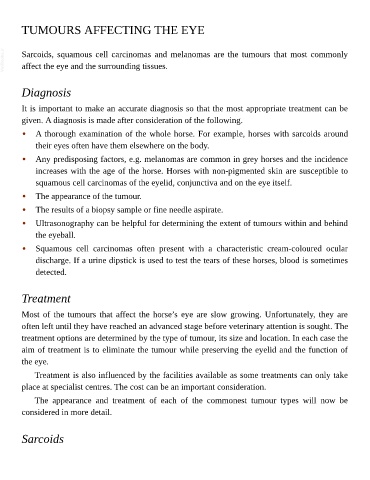Page 1009 - The Veterinary Care of the Horse
P. 1009
TUMOURS AFFECTING THE EYE
VetBooks.ir Sarcoids, squamous cell carcinomas and melanomas are the tumours that most commonly
affect the eye and the surrounding tissues.
Diagnosis
It is important to make an accurate diagnosis so that the most appropriate treatment can be
given. A diagnosis is made after consideration of the following.
• A thorough examination of the whole horse. For example, horses with sarcoids around
their eyes often have them elsewhere on the body.
• Any predisposing factors, e.g. melanomas are common in grey horses and the incidence
increases with the age of the horse. Horses with non-pigmented skin are susceptible to
squamous cell carcinomas of the eyelid, conjunctiva and on the eye itself.
• The appearance of the tumour.
• The results of a biopsy sample or fine needle aspirate.
• Ultrasonography can be helpful for determining the extent of tumours within and behind
the eyeball.
• Squamous cell carcinomas often present with a characteristic cream-coloured ocular
discharge. If a urine dipstick is used to test the tears of these horses, blood is sometimes
detected.
Treatment
Most of the tumours that affect the horse’s eye are slow growing. Unfortunately, they are
often left until they have reached an advanced stage before veterinary attention is sought. The
treatment options are determined by the type of tumour, its size and location. In each case the
aim of treatment is to eliminate the tumour while preserving the eyelid and the function of
the eye.
Treatment is also influenced by the facilities available as some treatments can only take
place at specialist centres. The cost can be an important consideration.
The appearance and treatment of each of the commonest tumour types will now be
considered in more detail.
Sarcoids

